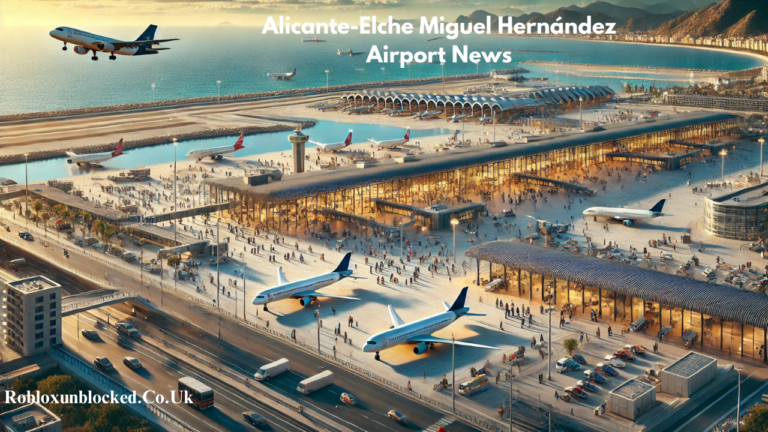Alicante-Elche Miguel Hernández Airport, located in the Costa Blanca region of Spain, has become a significant travel hub, not only for international visitors but also for domestic travellers. The airport, which was named after the famous Spanish poet Miguel Hernández in 2021, has consistently made headlines for its increasing passenger numbers, infrastructural improvements, and contributions to Spain’s economic recovery post-pandemic. In this article, we’ll explore recent news surrounding Alicante-Elche Miguel Hernández Airport, its notable achievements in 2024, and how it continues to shape the regional and national aviation landscape.
A Record-Breaking Year in Passenger Traffic
One of the most prominent headlines for Alicante-Elche Miguel Hernández Airport is its incredible rise in passenger numbers. In 2024, the airport reported a historic 19.2% increase in traffic, making it one of the busiest airports in Spain. This surge is driven by the airport’s expanded routes, enhanced services, and increased capacity to accommodate a growing number of international tourists and residents.
This growth is not only vital for the airport itself but also for the surrounding Costa Blanca region, a popular destination for holidaymakers. With new flight routes connecting Alicante to various European cities, the airport has become a preferred choice for travellers looking to explore the Mediterranean coastline. Additionally, the increase in passenger numbers highlights the region’s resilience and its ability to bounce back after the COVID-19 pandemic’s impact on travel.
Infrastructure Enhancements and Operational Efficiency
The recent success of Alicante-Elche Miguel Hernández Airport is also tied to its ongoing infrastructure developments. Over the last few years, significant investments have been made to improve airport facilities and services. These improvements have allowed the airport to handle more flights while ensuring smoother passenger experiences. The airport management has implemented state-of-the-art technologies to streamline operations, reduce delays, and enhance overall efficiency.
One of the key infrastructural upgrades includes the expansion of terminal facilities, enabling the airport to accommodate a higher number of travellers during peak seasons. Moreover, the airport has focused on sustainability initiatives, such as energy-efficient buildings and waste reduction measures, positioning itself as an environmentally responsible travel hub.
Expansion of International Routes
Alicante-Elche Miguel Hernández Airport has successfully expanded its range of international flight routes, connecting Spain to more destinations across Europe and beyond. This strategy has been crucial in attracting a diverse range of travellers, including tourists, expatriates, and business professionals. Airlines operating out of Alicante have launched new direct flights to cities such as Amsterdam, Berlin, Dublin, and various UK destinations.
The expansion of flight routes not only benefits passengers but also boosts the local economy by attracting more tourists to the region. The airport has become an essential gateway for both leisure and business travel, further solidifying its importance within the Spanish aviation sector. These new routes also contribute to the airport’s goal of being a premier travel hub, both regionally and internationally.
Role in the Costa Blanca’s Economic Development
Alicante-Elche Miguel Hernández Airport plays a crucial role in the economic development of the Costa Blanca region. As tourism remains one of the driving forces of the local economy, the airport’s ability to facilitate seamless travel to and from the region is essential. The rise in passenger numbers and the expansion of international routes have translated into more tourists arriving in the area, which, in turn, supports local businesses, hotels, restaurants, and cultural attractions.
Additionally, the airport has created numerous employment opportunities, not only within the aviation industry but also in related sectors such as transportation, logistics, and hospitality. The airport’s success is closely intertwined with the overall economic health of the region, providing a vital connection between the global travel market and the local economy.
Addressing Post-Pandemic Recovery
Like many airports around the world, Alicante-Elche Miguel Hernández Airport faced significant challenges during the COVID-19 pandemic. However, the airport’s ability to quickly recover and adapt to the changing travel landscape has been impressive. With the easing of travel restrictions in 2022 and 2023, the airport took proactive steps to rebuild traveller confidence, including implementing rigorous health and safety protocols.
The 19.2% increase in passenger traffic in 2024 can be seen as a clear indicator of the airport’s successful recovery. By focusing on health measures, operational efficiency, and an expanded network of flights, Alicante-Elche Airport managed to restore pre-pandemic levels of activity, demonstrating its resilience and strategic importance in the aviation industry.
Sustainability Initiatives
In an era where environmental concerns are becoming increasingly important, Alicante-Elche Miguel Hernández Airport has committed to adopting more sustainable practices. The airport’s management has introduced several green initiatives, including using renewable energy sources, energy-efficient lighting, and eco-friendly building materials in its expansions.
The airport has also implemented waste management programs and reduced water consumption in its facilities. These sustainability efforts align with Spain’s broader goals of reducing the environmental impact of its transport sector. As more travellers prioritize eco-friendly travel options, Alicante-Elche’s commitment to sustainability could be a significant draw for environmentally conscious tourists.
Future Prospects and Plans
Looking forward, Alicante-Elche Miguel Hernández Airport shows no signs of slowing down. With plans to further increase capacity and expand its facilities, the airport is preparing for continued growth in the coming years. This includes not only enhancing passenger services but also improving its cargo handling capabilities, making it a key player in Spain’s logistics and transportation industries.
Furthermore, the airport works closely with airlines and regional tourism boards to attract more flights and promote Costa Blanca as a top tourist destination. By investing in infrastructure, sustainability, and service quality, Alicante-Elche is poised to remain a vital component of Spain’s aviation sector for years to come.
Conclusion
Alicante-Elche Miguel Hernández Airport’s recent success is a reflection of its strategic importance to Spain’s tourism and transportation sectors. The 19.2% increase in passenger traffic in 2024 is just one indicator of the airport’s growing influence. With ongoing infrastructure improvements, expanded international routes, and a commitment to sustainability, the airport is well-positioned to continue its upward trajectory.
